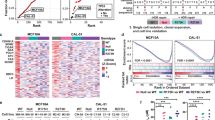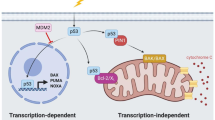Abstract
The p19ARF gene product responds to oncogenic stresses by interfering with the inhibitory effects of Mdm2 on p53, thus enhancing p53 activity and its antiproliferative functions. The absence of p19ARF in the mouse leads to early tumor susceptibility, presumably in part due to decreased p53 activity. To examine the tumorigenic cooperativity of p19ARF, Mdm2, and p53 in vivo, p19ARF-deficient mice were crossed first to p53-deficient mice and then to Mdm2 transgenic mice. The progeny were monitored for tumors. Cooperativity between p19ARF and p53 deficiencies in accelerating tumor formation was observed for most genotypes except p53−/− p19ARF−/− mice. p53−/− p19ARF−/− mice had a tumor incidence similar to p53−/− mice. In this context, tumor suppression by ARF appears to be primarily p53 dependent. The majority of the p19ARF+/− tumors deleted the wildtype p19ARF allele, in agreement with the previous studies, suggesting that p19ARF is a classic ‘two hit’ tumor suppressor. In a p53+/− background, however, all p19ARF+/− tumors retained a wildtype ARF allele and most also retained wildtype p53. In the second cross between p19ARF-deficient and Mdm2 transgenic mice, cooperativity in tumor incidence between Mdm2 overexpression and ARF deficiency was observed, consistent with the role of p19ARF in negatively regulating Mdm2 activity. These experiments further demonstrate in vivo the inter-relationships of the p19ARF-Mdm2-p53 signaling axis in tumor suppression.
This is a preview of subscription content, access via your institution
Access options
Subscribe to this journal
Receive 50 print issues and online access
$259.00 per year
only $5.18 per issue
Buy this article
- Purchase on Springer Link
- Instant access to full article PDF
Prices may be subject to local taxes which are calculated during checkout



Similar content being viewed by others
References
Alarcon-Vargas D and Ronai Z . (2002). Carcinogenesis, 23, 541–547.
Appella E and Anderson CW . (2001). Eur. J. Biochem., 268, 2764–2772.
Bai F, Pei XH, Godfrey VL and Xiong Y . (2003). Mol. Cell. Biol., 23, 1269–1277.
Donehower LA, Harvey M, Slagle BL, McArthur MJ, Montgomery CA, Butel JS and Bradley A . (1992). Nature, 356, 215–221.
Eischen CM, Weber JD, Roussel MF, Sherr CJ and Cleveland JL . (1999). Genes Dev., 13, 2658–2669.
Eymin B, Leduc C, Coll JL, Brambilla E and Gazzeri S . (2003). Oncogene, 22, 1822–1835.
Fero ML, Randel E, Gurley KE, Roberts JM and Kemp CJ . (1998). Nature, 396, 177–180.
Foster CJ and Lozano G . (2002). Oncogene, 21, 3525–3531.
Harvey M, McArthur MJ, Montgomery Jr CA, Butel JS, Bradley A and Donehower LA . (1993). Nat. Genet., 5, 225–229.
Jones SN, Hancock AR, Vogel H, Donehower LA and Bradley A . (1998). Proc. Natl. Acad. Sci. USA, 95, 15608–15612.
Jones SN, Roc AE, Donehower LA and Bradley A . (1995). Nature, 378, 206–208.
Kamb A, Gruis NA, Weaver-Feldhaus J, Liu Q, Harshman K, Tavtigian SV, Stockert E, Day III RS, Johnson BE and Skolnick MH . (1994). Science, 264, 436–440.
Kamijo T, Bodner S, van de Kamp E, Randle DH and Sherr CJ . (1999). Cancer Res., 59, 2217–2222.
Kamijo T, Weber JD, Zambetti G, Zindy F, Roussel MF and Sherr CJ . (1998). Proc. Natl. Acad. Sci. USA, 95, 8292–8297.
Kamijo T, Zindy F, Roussel MF, Quelle DE, Downing JR, Ashmun RA, Grosveld G and Sherr CJ . (1997). Cell, 91, 649–659.
Knudson Jr AG . (1984). Cancer Detect. Prev., 7, 1–8.
Krimpenfort P, Quon KC, Mooi WJ, Loonstra A and Berns A . (2001). Nature, 413, 83–86.
Kuo ML, Duncavage EJ, Mathew R, den Besten W, Pei D, Naeve D, Yamamoto T, Cheng C, Sherr CJ and Roussel MF . (2003). Cancer Res., 63, 1046–1053.
Leach FS, Tokino T, Meltzer P, Burrell M, Oliner JD, Smith S, Hill DE, Sidransky D, Kinzler KW and Vogelstein B . (1993). Cancer Res., 53 (Suppl.), 2231–2234.
Levine AJ . (1997). Cell, 88, 323–331.
Ljungman M . (2000). Neoplasia, 2, 208–225.
Lozano G and Elledge SJ . (2000). Nature, 404, 24–25.
McDonnell TJ, Montes de Oca Luna R, Cho S, Amelse LL, Chavez-Reyes A and Lozano G . (1999). J. Pathol., 188, 322–328.
Michael D and Oren M . (2002). Curr. Opin. Genet. Dev., 12, 53–59.
Montes de Oca Luna R, Wagner DS and Lozano G . (1995). Nature, 378, 203–206.
Palmero I, Pantoja C and Serrano M . (1998). Nature, 395, 125–126.
Reinke V, Bortner DM, Amelse LL, Lundgren K, Rosenberg MP, Finlay CA and Lozano G . (1999). Cell Growth Differ., 10, 147–154.
Serrano M, Lee H, Chin L, Cordon-Cardo C, Beach D and DePinho RA . (1996). Cell, 85, 27–37.
Sharpless NE, Bardeesy N, Lee KH, Carrasco D, Castrillon DH, Aguirre AJ, Wu EA, Horner JW and DePinho RA . (2001). Nature, 413, 86–91.
Sharpless NE, Ferguson DO, O'Hagan RC, Castrillon DH, Lee C, Farazi PA, Alson S, Fleming J, Morton CC, Frank K, Chin L, Alt FW and DePinho RA . (2001). Mol. Cell, 8, 1187–1196.
Sherr CJ . (2001). Nat. Rev. Mol. Cell. Biol., 2, 731–737.
Sherr CJ and Weber JD . (2000). Curr. Opin. Genet. Dev., 10, 94–99.
Tao W and Levine AJ . (1999). Proc. Natl. Acad. Sci. USA, 96, 6937–6941.
Tsai KY, MacPherson D, Rubinson DA, Nikitin AY, Bronson R, Mercer KL, Crowley D and Jacks T . (2002). Proc. Natl. Acad. Sci. USA, 99, 16865–16870.
Tsuji K, Mizumoto K, Sudo H, Kouyama K, Ogata E and Matsuoka M . (2002). Biochem. Biophys. Res. Commun., 295, 621–629.
Venkatachalam S, Shi YP, Jones SN, Vogel H, Bradley A, Pinkel D and Donehower LA . (1998). EMBO J., 17, 4657–4667.
Venkatachalam S, Tyner SD, Pickering CR, Boley S, Recio L, French JE and Donehower LA . (2001). Toxicol. Pathol., 29 (Suppl.), 147–154.
Vogelstein B, Lane D and Levine AJ . (2000). Nature, 408, 307–309.
Vousden KH and Lu X . (2002). Nat. Cancer Rev., 2, 594–604.
Weber JD, Jeffers JR, Rehg JE, Randle DH, Lozano G, Roussel MF, Sherr CJ and Zambetti GP . (2000). Genes Dev., 14, 2358–2365.
Weber HO, Samuel T, Rauch P and Funk JO . (2002). Oncogene, 21, 3207–3212.
Weber JD, Taylor LJ, Roussel MF, Sherr CJ and Bar-Sagi D . (1999). Nat. Cell Biol., 1, 20–26.
Zhang Y, Xiong Y and Yarbrough WG . (1998). Cell, 92, 725–734.
Zindy F, Eischen CM, Randle DH, Kamijo T, Cleveland JL, Sherr CJ and Roussel MF . (1998). Genes Dev., 12, 2424–2433.
Acknowledgements
We thank Martine Roussel and Chuck Sherr for providing the ARF-deficient mice and for helpful discussions. This work was supported by a grant from the National Cancer Institute to L Donehower. S Venkatachalam was supported by a postdoctoral training fellowship from the National Cancer Institute.
Author information
Authors and Affiliations
Corresponding author
Rights and permissions
About this article
Cite this article
Moore, L., Venkatachalam, S., Vogel, H. et al. Cooperativity of p19ARF, Mdm2, and p53 in murine tumorigenesis. Oncogene 22, 7831–7837 (2003). https://doi.org/10.1038/sj.onc.1206985
Received:
Accepted:
Published:
Issue Date:
DOI: https://doi.org/10.1038/sj.onc.1206985
Keywords
This article is cited by
-
Germline hemizygous deletion of CDKN2A–CDKN2B locus in a patient presenting with Li–Fraumeni syndrome
npj Genomic Medicine (2016)
-
ARF triggers cell G1 arrest by a P53 independent ERK pathway
Molecular and Cellular Biochemistry (2011)
-
The blind spot of p53
Nature (2010)
-
Tumour suppression by p53: a role for the DNA damage response?
Nature Reviews Cancer (2009)
-
Decreased Mdm2 expression inhibits tumor development induced by loss of ARF
Oncogene (2006)



